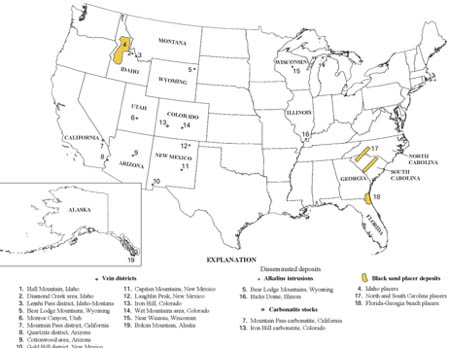In the United States, the fluorocarbonate, bastnäsite (space group: P6(bar)2c), became the predominant mineral source of thorium (thorbastnäsite, ThCa(CO3)2F2 · 3H2O; isomorphic) and so-called “light” Rare-Earth Elements (REE; the Lanthanide series, to the left of gadolinium). This mineral has three isomorphic class designations based on the predominant REE content, and represents a severe minority of the 59 thorium-bearing minerals known to exist on earth. The thorium was specific to the unusual and large bastnäsite deposit discovered in Mountain Pass, California, in the late 1940s. The major source of thorium and rare-earth elements, by mass and, arguably, by abundance, worldwide, is monazite.

Monazite is a useful, pervasive, phosphatic mineral and plays a major role in REE and Th, phosphate anion, as well as to a lesser extent, U, on earth. The monoclinic (space group: P21/n) monazite is part of a larger solid-solution group (see Figure 1, below), is isomorphic, regardless of the REE cation present, and co-incident with the Th4+ cation.

Figure 1: Monazite Series Structure (reproduced from Geology.com)

Figure 2: Mixed Monazite Crystal Cartoon (adapted from Arun B. et al 2014)
Monazite is a useful, pervasive, phosphatic mineral and plays a major role in REE and Th, phosphate anion, as well as to a lesser extent, U, on earth. The monoclinic (space group: P21/n) monazite is part of a larger solid-solution group (see Figure 1, below), is isomorphic, regardless of the REE cation present, and co-incident with the Th4+ cation.
References:
- https://www-pub.iaea.org/MTCD/Publications/PDF/TE-1877web.pdf
- https://www.mindat.org/min-42527.html
- https://geology.com/minerals/monazite.shtml
- Arun, B., Varghese, J., Surendran, K. P. Sebastian, M. T. Microwave, Dielectric and Thermal Properties of Mixed Rare-earth Orthophosphate[REmixPO4] Ceram. Intern. 40 pp13075–13081, 2014.
- Peelman, S., Sun, Z. H. I., Sietsma, J., Yang, Y-X. Chapter 21 – Leaching of Rare Earth Elements: Review of Past and Present Technologies in Rare Earths Industry: Technological, Economic, and Environmental Implications. Elsevier, Pages 319-334. 2016.


